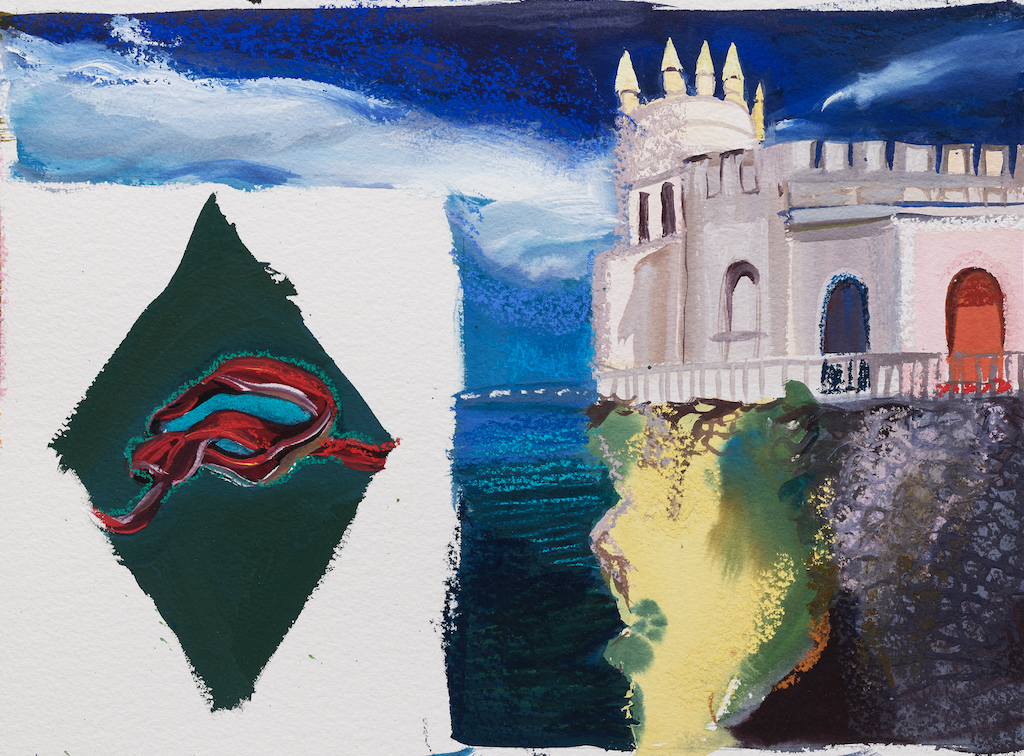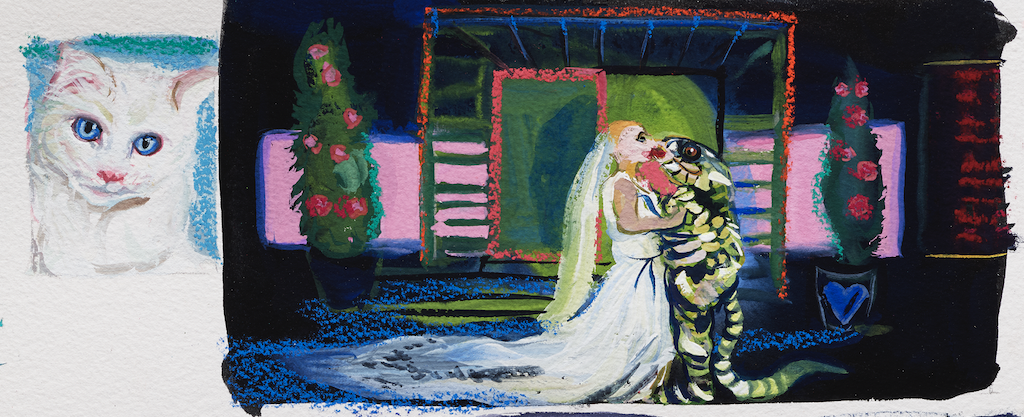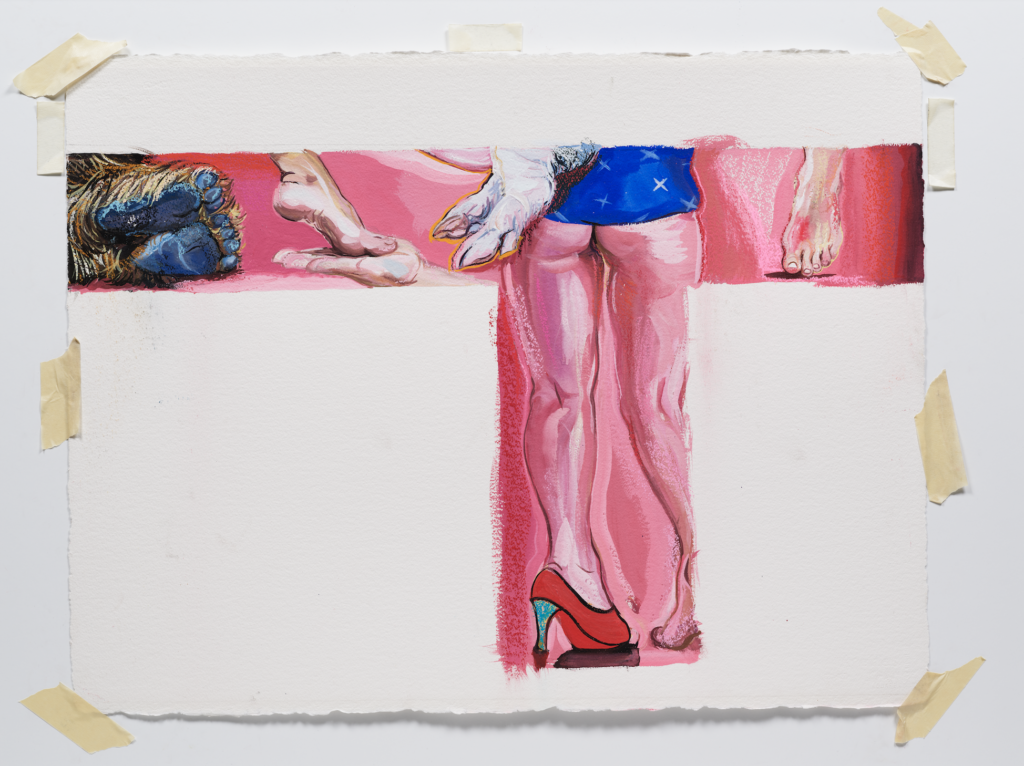
An illustration by the painter Natalie Frank for The Island of Happiness. One of Frank’s favorite tales is ‘The Green Serpent,” in which the prince is a snake, though only literally. “I love the image where you have to get into bed with this creature but you can’t look at him, and of course you look at him.”
Marie-Catherine Le Jumel de Barneville was born into a rich family in the fall of 1652. At thirteen, she was wed by her mother to the middle-aged Baron d’Aulnoy, who had purchased his title. Three months pregnant that same year, in the summer of 1666, she inked a jinx in the margins of a fifteenth-century religious play from their library:
It has been almost 200 years since this book was made, and whoever will have this Book should know that it was mine and that it belongs to our house. Written in Normandie near Honfleur. Adieu, Reader, if you have my book and I don’t know you and you don’t appreciate what’s inside, I wish you ringworm, scabies, fever, the plague, measles, and a broken neck. May God assist you against my maledictions.
Madame d’Aulnoy would bear six children. (The first two died young.) But she’d also become the mother of a best-selling genre in early modern France: the literary fairy tale, in which her curses would be very much at home.
In d’Aulnoy’s stories, heroines cream dragons and enemy armies. They run away from home, crossdress, shape-shift; they outwit, slay, rescue, lead. Occasionally, they faint or sob or splash their sisters’ ball gowns with mud. According to Jack Zipes, the doyen of folktale scholarship who recently translated a new collection of d’Aulnoy’s tales under the name of The Island of Happiness, at least two-thirds of seventeenth-century fairy tales were written by women. And though d’Aulnoy has historically taken a backseat to Charles Perrault, the author of “Sleeping Beauty” and “Little Red Riding Hood,” she published her first fairy tale in 1690, some seven years before he did. (The two writers had no contact, and ran in very different circles: he a well-connected Parisian bourgeois, she an outrageous aristocrat from the sticks.)
“The Tale of Mira” is exemplary of d’Aulnoy’s refreshing style. Tucked into a novel, as many of her fairy tales were, it’s presented as a lady’s letter or diary entry, relating a story she has heard while traveling. Once upon a time, a king and queen produced a daughter so beautiful that people couldn’t help but stare—they called this princess Mira, the Spanish for “Look.” “Anyone who saw her fell desperately in love with her. However, her pride and indifference made all of her lovers die,” d’Aulnoy writes. “Consequently, she depopulated her father’s kingdom.” She adds: “Moreover, the surrounding countries were full of dead or dying lovers.” An oracle said that Mira would have to go—the fates would teach her to be more considered with other people’s hearts. So Mira roamed the globe dressed as a shepherdess, leaving expired men in her wake, until one day she met a shy, young, and possibly gay count, whom she adored. Finding him immune to her charms, Mira died of grief at his castle, where locals afterward claimed to hear the “deep sighs” of the man-eater’s ghost.
These seventeenth-century fairy tales, Zipes told me, “had to do with women’s real lives, and I don’t believe d’Aulnoy’s life was so different from a lot of the women in her time.” That’s hard to prove in great detail. D’Aulnoy’s biography is, as Volker Schröder, a scholar of Louis XIV’s France at Princeton, told me on a phone call, full of gaps, gray areas, and gossip. Schröder, who discovered the teen bride’s threatening marginalia a few years ago, has puzzled together some of her life story from archival documents, and he blogs about his findings.
D’Aulnoy’s marriage was no success. “I have it from her that he was a terrible husband—a violent husband,” Schröder said. In 1669, d’Aulnoy and her mother framed the baron for bad-mouthing the king, a crime punishable by death, but their plot came apart in court, and d’Aulnoy is said to have gone to jail with a babe in tow. Over the next fifteen years, the d’Aulnoys didn’t make peace but didn’t divorce, either. Then, in December 1685, the baron, unable to put up the dowry for their eldest daughter’s marriage, forced his wife to give the fief she had inherited to her prospective son-in-law. “And this”—Schröder inhaled sharply—“she didn’t like.” Though the baron, who worked a day job and did stints in debtor’s prison, promised to compensate the baroness with an annuity of 1,000 livres (about $35,000), the money either came irregularly or not at all. Lawsuits ensued, as did some unspecified mauvaise conduite (“bad behavior”) on the part of Madame d’Aulnoy. In 1686, she was arrested by order of the king (presumably at her husband’s urging) and pushed first into a convent in the Loire Valley, then another in Paris—not as a nun, but as a detainee. She stayed there until at least February 1695, and we don’t know what her decade of lockup looked like, only that she retained access to her daughters, her lawyer, and her publisher. (Not bad.) In fact, it was during this period of imprisonment that her first fairy tale appeared in print.
Her first book of stories, Les contes des fées, coined the new genre’s name. The earliest of her tales, “The Island of Happiness”—in which a dude voluntarily leaves his darling to go and make war, then dies in battle—has no happy ending, only the poetic justice she favored above all else. D’Aulnoy’s fairy tales run long and are not addressed to children. She marbles fantasy with realism, and burnishes it with vim and wit. Often, the narration is scathing: one stepsister is “less noble than an oyster in its shell.” D’Aulnoy’s most reliable crowdpleaser is “Belle-Belle, or the Chevalier Fortuné,” in which three sisters, one “brave amazon” after the other, attempt to pass themselves off as knights. Only the youngest is made of the right stuff. It’s a Shakespearean romp in which Belle-Belle becomes the king’s squire and then his wife, but not before (s)he has taken the reins and saved the day. In this way, D’Aulnoy dethroned the reigning image of female nature. Her heroines are three-dimensional portraits of women trapped between rocks and hard places, doing pretty much their best to hold on to their virtues. As the feminist painter Natalie Frank, who illustrated the new collection, told me: “Every female character feels real and burdened and formed by what they have been through.” In “The Ram,” the heroine’s nonhuman boyfriend dies of heartbreak. “D’Aulnoy here says maybe that’s the better ending for the woman: to control the kingdom and not care about husbands,” Schröder suggested. “The explicit moral doesn’t say that, but the implicit message does. She has these tales where things are a bit more complicated.”

Frank’s jewel-bright drawings suggest Mary Cassatt if Cassatt had allied not with Degas but Goya. They fit d’Aulnoy’s cast-like couture.
In “The White Cat,” a princess has been turned into a tiny, sweet, and extremely resourceful mouser. The story is full of precious miniatures that defy belittlement, including a ruby-encrusted box that opens upon a walnut, inside of which is a hazelnut, then a cherrystone, a kernel, a grain of wheat, a millet seed, and, finally, a four-hundred-yard-long cloth, resplendently embroidered. “That’s a conscious choice when the prevailing discourse—especially around Louis XIV—is one of total grandeur,” Rori Bloom, a scholar at the University of Florida, told me. “It’s an upset about what you value.” “The White Cat” itself impearls a larger novel whose hero, Dandinardière, a concussed wannabe knight based on Don Quixote, betroths himself to a dreamy girl who has no dowry but whose storytelling talent rivals Scheherazade’s. D’Aulnoy often points to a strong alliance being the most important thing. From the poem that ends her tale “The Blue Bird”:
Better to be a bird of any hue
A raven, crow, an owl, I do protest,
Than stick for life to a partner like glue
Who scorns you, or whom you detest.
D’Aulnoy managed to write herself a happier ending. By January 1698, she was legally separated from her husband and had a place on rue Saint-Benoît in Paris. There she hosted one of the era’s more interesting literary salons, sometimes appearing in costume as characters from her fairy tales. Schröder believes that she had already composed her catalog at the convent, and not in the midst of these raucous parties. “She still saw herself as a noblewoman,” he said, “and nobles aren’t supposed to be serious professionals. It all has to look so effortless.”
Even so, today it’s tempting to frame the mother of fairy tales as some sort of radical. Bloom, who is at work on a book about d’Aulnoy and another conteuse, has an allergy to reading too much into their lives, yet she still hears a protofeminist tone in the tales of Madame d’Aulnoy. In “The Little Good Mouse,” for example, after Queen Joliette’s husband and jailer dies, a fairy urges her, “Let us not waste any time, we must organize a coup d’état; let us go to the castle’s big assembly too and address a harangue to the people!” Fairies—typically fairy godmothers—are always stirring the pot, altering fate, dishing out help and harm. (How else did all those people become birds and rams and cats?) The world of d’Aulnoy’s fiction is governed by powerful women.
According to some of the bavardage, d’Aulnoy helped her friend Angélique Tiquet hire a hitman to kill Tiquet’s abusive husband, a member of parliament who had wooed her with bouquets peppered with real diamonds but whose fortune turned out to be fake. Things went sideways: the husband survived the hit and Tiquet was executed. There’s no reliable source for d’Aulnoy’s involvement, yet it’s easy to believe in—because Marie-Catherine d’Aulnoy often comes off as just the kind of fairy fatale she liked to make up. Woe to the fool who forgets that a woman invented the literary fairy tale, and that fairies are not to be fucked with.
from The Paris Review https://ift.tt/33HH9El

Comments
Post a Comment